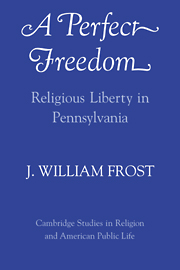Book contents
- Frontmatter
- Contents
- Acknowledgments
- Preface to This Paperback Reissue
- Introduction: The Pennsylvania Traditions of Religious Liberty
- I The Creation of Religious Liberty in Early Pennsylvania
- II Pacifism and Religious Liberty
- III The Clergy and Religious Liberty
- IV Religious Liberty in the Revolution
- V Religious Liberty and the Republic
- VI Politicians Debate Religious Liberty
- VII The Churches and Religious Liberty
- VIII The Legal Implications of Religious Liberty
- IX Religious Liberty and the Catholic and Jewish Minorities
- Epilogue: The Dismantling
- Notes
- Bibliography
- Index
Introduction: The Pennsylvania Traditions of Religious Liberty
- Frontmatter
- Contents
- Acknowledgments
- Preface to This Paperback Reissue
- Introduction: The Pennsylvania Traditions of Religious Liberty
- I The Creation of Religious Liberty in Early Pennsylvania
- II Pacifism and Religious Liberty
- III The Clergy and Religious Liberty
- IV Religious Liberty in the Revolution
- V Religious Liberty and the Republic
- VI Politicians Debate Religious Liberty
- VII The Churches and Religious Liberty
- VIII The Legal Implications of Religious Liberty
- IX Religious Liberty and the Catholic and Jewish Minorities
- Epilogue: The Dismantling
- Notes
- Bibliography
- Index
Summary
Most readers of this book will be seeking insight into the meaning of the religious clauses in the First Amendment. The study of the history of religious liberty is particularly pertinent today because of the increasing debate over original intent and the controversy arising from recent Supreme Court decisions concerning school prayer. The danger is that the contemporary issues sometimes reverse historical priorities. Until the mid-twentieth century, Pennsylvanians held the First Amendment to be a symbolic testimony to the nation's adoption of their beliefs and practices on religious freedom. The Federal disestablishment clause was important for what it showed about the religious clauses in the 1790 Pennsylvania constitution. The First Congress's inclusion of religion in the Bill of Rights had little impact on Pennsylvania's conduct for the next one hundred and fifty years.
In the colonial period Pennsylvania's pattern of separation of church and state paved the way for similar policies in other states and the Federal government. Thomas Jefferson in his Notes on Virginia, written in 1781 and published in 1785, saw the postrevolutionary Virginia disestablishment of the Church of England as growing out of a pattern begun in Pennsylvania one hundred years earlier. The radical experiment in religious liberty, wrote Jefferson, took place in Pennsylvania (and New York) and not in Virginia.
Scholars have long recognized that the Founding Fathers incorporated republican ideology and colonial experience in creating the constitutions for the states and the new nation.
- Type
- Chapter
- Information
- A Perfect FreedomReligious Liberty in Pennsylvania, pp. 1 - 9Publisher: Cambridge University PressPrint publication year: 1990



